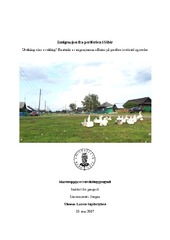Emigrasjon fra periferien i Sibir. Utvikling eller avvikling? En studie av migrasjonens effekter på perifere levebrød og steder.
Master thesis
Permanent lenke
https://hdl.handle.net/1956/16099Utgivelsesdato
2017-06-21Metadata
Vis full innførselSamlinger
- Department of Geography [676]
Sammendrag
This master thesis is about the impacts of periphery-to-centre migration on families and places left behind. I have applied livelihood system theory as a framework to investigate the effects of migration as a livelihood strategy. The main question has been whether migration can serve as a contribution to the creation of sustainable livelihoods in the periphery. It has also been looked into the effects of migration on local development. I have chosen to do my do my field research in Russia, and focus on the southern region of Siberia in the federal subject Krasnoyarsk Krai and the Republic of Khakassia. I have conducted the fieldwork in four different localities in the periphery around the city of Krasnoyarsk: Pamyati 13 Bortsov, Otnoshka, Zhemchuzhny and Zelenogorsk. In this process, I have learnt about the challenges of life in Russia’s periphery whether rural or urban. I have looked into what constitutes a peripheral livelihood and what people do to cope in their everyday. I have, with the help of migration theory investigated the reasons people have for leaving and connected this to livelihood theory to see if migration also works as a family strategy and not only as an escape for the individual. The methods applied have included a questionnaire survey and interviews. The results are, as other migration and livelihood research, ambivalent to the connection between migration and development. While it certainly can help secure family welfare, its impact on family and local development is rather modest and overshadowed by the bigger structures that fuels the migration itself.
